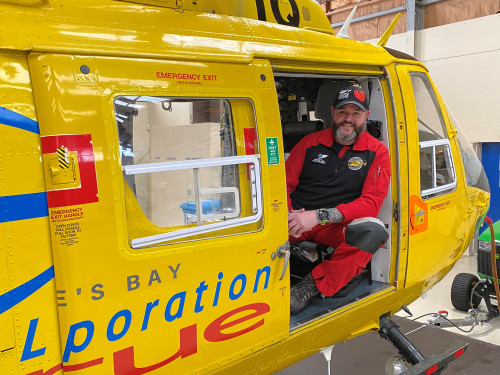
Being winched from a helicopter down into the devastation of Cyclone Gabrielle put a Hawke’s Bay paramedic inside some of the worst devastation he had seen in 20 years’ experience.
This Saturday 8 July marks International Paramedics Day, to celebrate and acknowledge the vital work they do, such as the four Critical Care Paramedics at the Hawke’s Bay Rescue Helicopter Trust.
These paramedics are often winched down into some of the most remote locations, providing urgent medical care in what can be life threatening situations.
Members of the public are more likely to meet a paramedic on the ground than hanging from a helicopter. But often the situation is still fraught.
Paramedics make a real difference to people’s lives, says Andrew Nwosu, Te Whatu Ora Chief Allied Health Professions Officer in Hawke’s Bay.
“Paramedics are a critical profession within allied health and to the health workforce. They are the first point of contact for patients who dial 111, providing assessment, treatment and diagnosis for a wide range of conditions,” Mr Nwosu says.
The Lowe Corporation rescue helicopter team assists in about 400 missions each year, or 35 a month. In the wake of Cyclone Gabrielle, the team completed 105 jobs in February alone.
They also regularly transport people to Hawke’s Bay Fallen Soldiers’ Memorial Hospital’s Emergency Department.
Steve Lynch has been with the Lowe Corporation rescue helicopter for four years and has 20 years of experience as a St John paramedic. He couldn’t believe the level of devastation he saw flying into the Esk Valley on 14 February.
The first few hours were spent rescuing people from the flood water and off rooftops in Esk Valley and then Pakowhai.
“As we were flying around we were seeing more and more people stranded on rooftops. They were cold and wet and we needed to get them out as soon as possible,” Mr Lynch says.
It was non-stop for the team and they were grateful for the assistance from other rescue helicopters who flew in to help from Taupo, Gisborne, Hamilton and Dunedin.
Mr Lynch says attending to people in their hour of need is incredibly rewarding.
“They might be in tremendous pain or respiratory distress and sometimes we put them into a drug-induced coma and on a ventilator and fly them directly to a critical care facility.
“However, the medical training is only part of what we do. We’re quite often put into an austere environment, rescuing hunters, trampers or those in the water. You’re lowered down, dealing with the patient’s medical needs, and then securing them to be winched up into the helicopter.”
The Rescue Helicopter Trust General Manager Ian Wilmot says it’s thanks to Government funding in recent years that they’ve been able to build up their team of four Critical Care Paramedics, four Crewmen and four Pilots. The team operates 24 hours a day, 365 days a year, and is free of charge to everyone in the community.
https://www.youtube.com/watch?v=0t4zH_l4g74






Post your comment
Comments
No one has commented on this page yet.